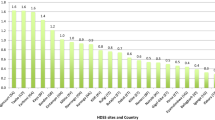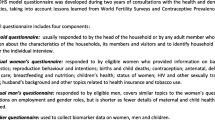Abstract
In 1999, the Canadian Perinatal Surveillance System of Health Canada decided to undertake a national survey of Canadian women’s experiences of their pregnancy, birth and postpartum care. The challenges encountered in selecting a representative sampling frame and developing a sound methodology for conducting a survey of Canadian women at six months after birth are addressed. We considered the advantages and disadvantages of six different sampling options. A sample based on the Census emerged as the optimal approach for providing the most reliable and representative sample.
Résumé
En 1999, les responsables du Système de surveillance périnatale de Santé Canada ont décidé d’entreprendre une enquête nationale sur l’expérience des Canadiennes relativement à leur grossesse, à leur accouchement et aux soins postnatals qu’elles ont reçus. Nous présentons ici les problèmes rencontrés à propos du choix d’une base d’échantillonnage représentative et de l’élaboration d’une méthode valable pour mener une enquête auprès de Canadiennes six mois après leur accouchement. Nous avons tenu compte des avantages et des inconvénients de six formules d’échantillonnage, et celle fondée sur le recensement nous a semblé la meilleure pour obtenir l’échantillon le plus fiable et le plus représentatif.
Similar content being viewed by others
References
Health Canada. Canadian Perinatal Health Report, 2003. Ottawa: Minister of Public Works and Government Services Canada, 2003.
Van Teijlingen ER, Rennie A-M, Mundley V, Graham W. The importance of conducting and reporting pilot studies: The example of the Scottish Births Survey. J Adv Nurs 2001;34:289–95.
Fraser AM, Brockert JE, Ward RH. Association of young maternal age with adverse pregnancy outcomes. N Engl J Med 1995;332:1113–17.
Luo ZC, Kierans WJ, Wilkins R, Listong RM, Uh SH, Kramer MS. Infant mortality among First Nations versus non-First Nations in British Columbia: Temporal trends in rural versus urban areas, 1981–2000. Int J Epidemiol 2004;3(6):1252–59.
Women’s Health Office. Immigrant and Refugee Women’s Health Care. McMaster University Faculty of Health Sciences Newsletter, March 1999.
Brown S, Lumley J. The 1993 Survey of Recent Mothers: Issues in survey design, analysis and influencing policy. Int J Qual Hlth Care 1997;9(4):265–77.
Health Canada. Exclusive Breastfeeding Duration–2004 Health Canada Recommendation. Available online at: https://doi.org/www.hc-sc.gc.ca/fn-an/nutrition/child-enfant/infant-nourisson/excl_bf_dur-dur_am_excl_e.html (Accessed September 26, 2005).
Dzakpasu S, Chalmers B, for the Maternity Experiences Study Group of the Canadian Perinatal Surveillance System. Canadian Maternity Experiences Survey: Pilot Study. Birth 2005;32:34–38.
Fair M, Cyr M. The Canadian Birth Data Base: A new research tool to study reproductive outcomes. Hlth Reports 1993;5(3):281–87.
Bell-Syer S, Moffett J. Recruiting patients to randomized trials in primary care: Principles and case studies. Fam Practice 2000;17(20):187–91.
Peto V, Coulter A, Bond A. Factors affecting general practitioner’s recruitment of patients into a prospective study. Fam Practice 1993;10:207–11.
Stilton B, Woffard J, Gosselink C, McClatchey M, Brelke K, Conbroy C, et al. Recruitment and retention of physicians for primary care research. J Community Health 2002;27(2):79–89.
de Witt N, Quantero D, Zuthoff P, Neumans M. Participation and successful patient recruitment in primary care. J Fam Practice - online. 2001;50(11):976.
Chan B, Willett J. Factors influencing participation in obstetrics by obstetrician gynecologists. Obstet and Gynecol 2004;103(3):493–98.
Levitt C, Kaczorowski J. Provision of intra-partum care by GP/FP’s in Canada: An update. CMAJ 1999;160(6):815–16.
Kepner C, Tregoe B. The New Rational Manager. Windsor: Kepner-Tregoe Publications, 1997.
Statistics Canada’s Quality Assurance Framework, 2002. Ottawa: Ministry of Industry, 2002. Catalogue No. 12-586-XIE.
Author information
Authors and Affiliations
Corresponding author
Additional information
For the Maternity Experiences Study Group of the Canadian Perinatal Surveillance System, Public Health Agency of Canada.
Rights and permissions
About this article
Cite this article
Chalmers, B., Dzakpasu, S., Heaman, M. et al. Conducting a National Survey of Women’s Perinatal Experiences in Canada. Can J Public Health 98, 281–283 (2007). https://doi.org/10.1007/BF03405403
Received:
Accepted:
Published:
Issue Date:
DOI: https://doi.org/10.1007/BF03405403




